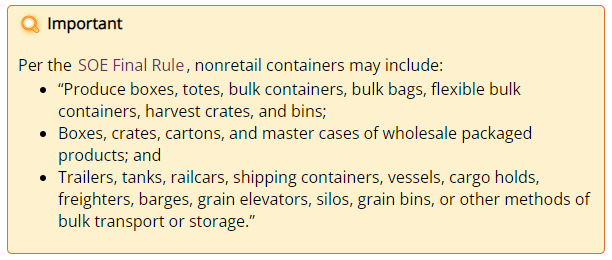NOP New Final Rule - Labelling of non-retail containers and calculating the percentage of organic ingredients

The emergence of longer and more complex supply chains has made the need for more verification tools and methods necessary.
1) The Strengthening Organic Enforcement (SOE) Final Rule requires that operations label nonretail containers (see section "A") with critical information that will help to prevent commingling of organic and non-organic products and contact with prohibited substances while supporting traceability and verification.
Section C, Labeling of Nonretail Containers, in the SOE Final Rule outlines risk-based strategies that will help to achieve the following objectives for the organic market:
- Protect organic integrity.
- Decrease the risk of commingling.
- Facilitate organic verification traceability.
2) The rule also clarifies how to calculate the percentage of organic ingredients in multi-ingredient products (see section "B").
In addition, changes described in the Final Rule’s Section O, Calculating the Percentage of Organically Produced Ingredients, finalized the National Organic Program (NOP)’s work on a draft guidance document that has been of long-standing interest to the organic community.
- What information must be displayed on nonretail containers and related audit trail documentation?
- How must operations calculate the percentage of organic content?
A) Labelling of nonretail containers
The SOE Final Rule clarifies the definition of a nonretail container. A nonretail container can be any container used for shipping or storage of an agricultural product that is not used in the sale of the product or in the retail display.
Examples of nonretail containers may include the following:

Paragraph 7 CFR §205.307 also defines the inclusion of the following requirements for labeling of nonretail containers used to ship or store certified organic agricultural products:
- Only the most critical information—Organic identification and information linking the container to the audit trail documentation— is now required on nonretail container labels.
- Clear identification—Product contents are to be clearly identified as “organic” on the labelby using a short statement (like “organic”), an abbreviation, an acronym, or a USDA organic seal.
Aim:
A clear identification reduces the possibility of commingling of the organic product and its accidental contact with prohibited substances.
Note:
Operations may use temporary signs or labels for containers that are difficult to label due to size, shape or material or similar.
- Unique information—Information, such as the production lot number or shipping identification on the label, must link the container to audit trail documentation.
- Audit trail documentation—Audit records enable certifiers to identify the source, transfer of ownership as well as transport of a product. Nonretail containers must identify the last certified operationthat handled the agricultural product. This identification enforces a recordkeeping requirement in the SOE Final Rule to trace back to the last certified operation in a supply chain. (Refer to §205.103(b)(2) and the Supply Chain Traceability and Organic Fraud Prevention SOE Final Rule primer.)
Optional information on non-retail labels:
This includes additional information such as special handling instructions, operation or certifier names, and contact information.
Attention:
Paragraph §205.307(a)(1) does not apply to non-retail containers used to ship or store agricultural products packaged for retail sale with organic identification visible on the retail label. Master cases, pallets or other containers do not need additional organic identification if the retail packages that they hold indicate the products are organic (for example, if the USDA organic seal is displayed visibly).

B) Calculating the percentage of organically produced ingredients
In paragraph 7 CFR §205.302(a), the SOE Final Rule clarifies the method for calculating the percentage of organically produced ingredients.
Aim:
Stakeholders can conduct more accurate and consistent mass balance calculations in traceability audits of multi-ingredient products.
The regulation in this paragraph originally described the calculation of the percentage of organic content as indicated below:

Note: The original calculation method did not account for water loss from ingredients such as occurring with fruit during baking or other processing.
Operations must now calculate the percentage of organic content as indicted below:

Note: Water and salt that are added as ingredients at formulation are excluded from the calculation.
The SOE Final Rule also covers two specific cases under the paragraph 7 CFR §205.302 (a) that are both related to this calculation and consistent with calculating based on the weight of all ingredients at formulation.
- Solid and liquid products—If products contain organically produced ingredients in both solid and liquid form, use the following calculation:

Note: Water and salt that are added as ingredients at formulation are excluded from the calculation.
- Liquid products—If the product and ingredients are liquid, use the following calculation:

If the liquid product is identified on the principal display panel or information panel as being reconstituted from concentrates, the calculation should be made based on single-strength concentrations of all ingredients. (Note: Water and salt added as ingredients at formulation are excluded from the calculation.)
Fell free to contact your next Kiwa BCS office in case you have questions.
For further information regarding NOP visit our NOP-page.
